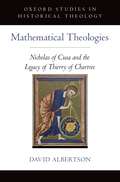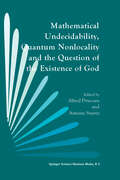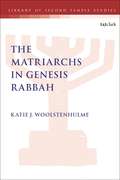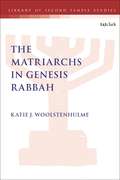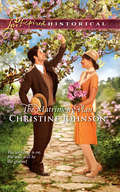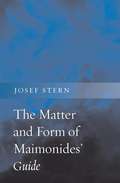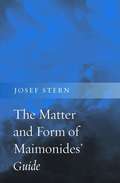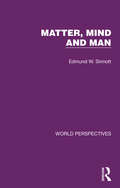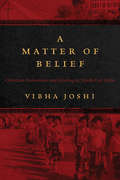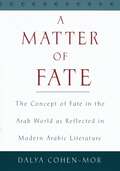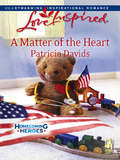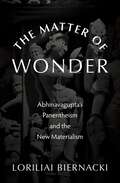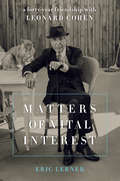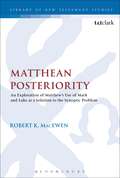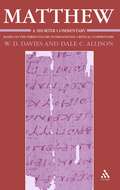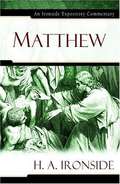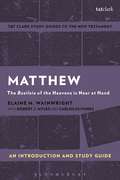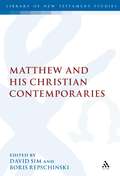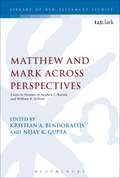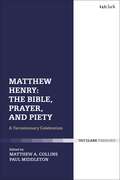- Table View
- List View
Mathematical Theologies: Nicholas of Cusa and the Legacy of Thierry of Chartres (Oxford Studies in Historical Theology)
by David AlbertsonThe writings of theologians Thierry of Chartres (d. 1157) and Nicholas of Cusa (d. 1464) represent a lost history of momentous encounters between Christianity and Pythagorean ideas before the Renaissance. Their robust Christian Neopythagoreanism reconceived the Trinity and the Incarnation within the framework of Greek number theory, challenging our contemporary assumptions about the relation of religion and modern science. David Albertson surveys the slow formation of theologies of the divine One from the Old Academy through ancient Neoplatonism into the Middle Ages. Against this backdrop, Thierry of Chartres's writings stand out as the first authentic retrieval of Neopythagoreanism within western Christianity. By reading Boethius and Augustine against the grain, Thierry reactivated a suppressed potential in ancient Christian traditions that harmonized the divine Word with notions of divine Number. Despite achieving fame during his lifetime, Thierry's ideas remained well outside the medieval mainstream. Three centuries later Nicholas of Cusa rediscovered anonymous fragments of Thierry and his medieval readers, and drew on them liberally in his early works. Yet tensions among this collection of sources forced Cusanus to reconcile their competing understandings of Word and Number. Over several decades Nicholas eventually learned how to articulate traditional Christian doctrines within a fully mathematized cosmology-anticipating the situation of modern Christian thought after the seventeenth century. Mathematical Theologies skillfully guides readers through the newest scholarship on Pythagoreanism, the school of Chartres, and Cusanus, while revising some of the categories that have separated those fields in the past.
Mathematical Theologies Osht C: Nicholas Of Cusa And The Legacy Of Thierry Of Chartres
by David AlbertsonMathematical Undecidability, Quantum Nonlocality and the Question of the Existence of God
by A. Driessen Antoine SuarezOn January 22, 1990, the late John Bell held at CERN (European Laboratory for Particle Physics), Geneva a seminar organized by the Center of Quantum Philosophy, that at this time was an association of scientists interested in the interpretation of quantum mechanics. In this seminar Bell presented once again his famous theorem. Thereafter a discussion took place in which not only physical but also highly speculative epistemological and philosophical questions were vividly debated. The list of topics included: assumption of free will in Bell's theorem, the understanding of mind, the relationship between the mathematical and the physical world, the existence of unobservable causes and the limits of human knowledge in mathematics and physics. Encouraged by this stimulating discussion some of the participants decided to found an Institute for Interdisciplinary Studies (lIS) to promote philosoph ical and interdisciplinary reflection on the advances of science. Meanwhile the lIS has associated its activities with the Swiss foundation, Fondation du Leman, and the Dutch foundation, Stichting Instudo, registered in Geneva and Amsterdam, respectively. With its activities the lIS intends to strengthen the unity between the professional activities in science and the reflection on fun damental philosophical questions. In addition the interdisciplinary approach is expected to give a contribution to the progress of science and the socio economic development. At present three working groups are active within the lIS, i. e. : - the Center for Quantum Philosophy, - the Wealth Creation and Sustainable Development Group, - the Neural Science Group.
The Matriarchs in Genesis Rabbah (The Library of Second Temple Studies)
by Katie J. WoolstenhulmeKatie J. Woolstenhulme considers the pertinent questions: Who were 'the matriarchs', and what did the rabbis think about them? Whilst scholarship on the role of women in the Bible and Rabbinic Judaism has increased, the authoritative group of women known as 'the matriarchs' has been neglected. This volume consequently focuses on the role and status of the biblical matriarchs in Genesis Rabbah, the fifth century CE rabbinic commentary on Genesis. Woolstenhulme begins by discussing the nature of midrash and introducing Genesis Rabbah; before exploring the term 'the matriarchs' and its development through early exegetical literature, culminating in the emergence of two definitions of the term in Genesis Rabbah – 'the matriarchs' as the legitimate wives of Israel's patriarchs, and 'the matriarchs' as a reference to Jacob's four wives, who bore Israel's tribal ancestors. She then moves to discuss 'the matriarchal cycle' in Genesis Rabbah with its three stages of barrenness; motherhood; and succession. Finally, Woolstenhulme considers Genesis Rabbah's portrayal of the matriarchs as representatives of the female sex, exploring positive and negative rabbinic attitudes towards women with a focus on piety, prayer, praise, beauty and sexuality, and the matriarchs' exemplification of stereotypical, negative female traits. This volume concludes that for the ancient rabbis, the matriarchs were the historical mothers of Israel, bearing covenant sons, but also the present mothers of Israel, continuing to influence Jewish identity.
The Matriarchs in Genesis Rabbah (The Library of Second Temple Studies)
by Katie J. WoolstenhulmeKatie J. Woolstenhulme considers the pertinent questions: Who were 'the matriarchs', and what did the rabbis think about them? Whilst scholarship on the role of women in the Bible and Rabbinic Judaism has increased, the authoritative group of women known as 'the matriarchs' has been neglected. This volume consequently focuses on the role and status of the biblical matriarchs in Genesis Rabbah, the fifth century CE rabbinic commentary on Genesis. Woolstenhulme begins by discussing the nature of midrash and introducing Genesis Rabbah; before exploring the term 'the matriarchs' and its development through early exegetical literature, culminating in the emergence of two definitions of the term in Genesis Rabbah – 'the matriarchs' as the legitimate wives of Israel's patriarchs, and 'the matriarchs' as a reference to Jacob's four wives, who bore Israel's tribal ancestors. She then moves to discuss 'the matriarchal cycle' in Genesis Rabbah with its three stages of barrenness; motherhood; and succession. Finally, Woolstenhulme considers Genesis Rabbah's portrayal of the matriarchs as representatives of the female sex, exploring positive and negative rabbinic attitudes towards women with a focus on piety, prayer, praise, beauty and sexuality, and the matriarchs' exemplification of stereotypical, negative female traits. This volume concludes that for the ancient rabbis, the matriarchs were the historical mothers of Israel, bearing covenant sons, but also the present mothers of Israel, continuing to influence Jewish identity.
The Matrimony Plan (Mills And Boon Love Inspired Historical Ser.)
by Christine JohnsonA Society Princess—and a Penniless Preacher?
The Matter and Form of Maimonides' Guide
by Josef SternMaimonides’ Guide of the Perplexed is generally read as an attempt either to harmonize reason and revelation or to show that they are irreconcilable. Moving beyond these familiar debates, Josef Stern argues that the perplexity addressed in this famously enigmatic work is the tension between human matter and form: the body and intellect.
The Matter and Form of Maimonides' Guide
by Josef SternMaimonides’ Guide of the Perplexed is generally read as an attempt either to harmonize reason and revelation or to show that they are irreconcilable. Moving beyond these familiar debates, Josef Stern argues that the perplexity addressed in this famously enigmatic work is the tension between human matter and form: the body and intellect.
Matter, Mind and Man (World Perspectives #9)
by Edmund W. SinnottOriginally published in 1957 and written by one of the 20th Century’s leading botanists and a fierce advocate of organicism, this book explores concepts about man and his relation to life and the universe, and about the great creative and spiritual powers within and around him. The author provides answers to perennial human questions whilst discussing the problems of sin, justice, ugliness and beauty.
Matter, Mind and Man (World Perspectives #9)
by Edmund W. SinnottOriginally published in 1957 and written by one of the 20th Century’s leading botanists and a fierce advocate of organicism, this book explores concepts about man and his relation to life and the universe, and about the great creative and spiritual powers within and around him. The author provides answers to perennial human questions whilst discussing the problems of sin, justice, ugliness and beauty.
A Matter of Belief: Christian Conversion and Healing in North-East India
by Vibha Joshi‘Nagaland for Christ’ and ‘Jesus Saves’ are familiar slogans prominently displayed on public transport and celebratory banners in Nagaland, north-east India. They express an idealization of Christian homogeneity that belies the underlying tensions and negotiations between Christian and non-Christian Naga. This religious division is intertwined with that of healing beliefs and practices, both animistic and biomedical. This study focuses on the particular experiences of the Angami Naga, one of the many Naga peoples. Like other Naga, they are citizens of the state of India but extend ethnolinguistically into Tibeto-Burman south-east Asia. This ambiguity and how it affects their Christianity, global involvement, indigenous cultural assertiveness and nationalist struggle is explored. Not simply describing continuity through change, this study reveals the alternating Christian and non-Christian streams of discourse, one masking the other but at different times and in different guises.
A Matter of Fate: The Concept of Fate in the Arab World as Reflected in Modern Arabic Literature
by Dalya Cohen-MorDalya Cohen-Mor examines the evolution of the concept of fate in the Arab world through readings of religious texts, poetry, fiction, and folklore. She contends that belief in fate has retained its vitality and continues to play a pivotal role in the Arabs' outlook on life and their social psychology. Interwoven with the chapters are 16 modern short stories that further illuminate this fascinating topic.
A Matter of the Heart: A 2-in-1 Collection (Homecoming Heroes #4)
by Patricia DavidsOperating on a sick little boy is Dr. Nora Blake's responsibility. Answering a determined reporter's questions about the surgery is not. Especially because Robert Dale is delving into her life, too. Nora has her share of secrets. She won't allow a newspaper to profit from the child's story–or her own.
The Matter of Wonder: Abhinavagupta's Panentheism and the New Materialism
by Loriliai BiernackiIn the early 11th century, the Kashmiri philosopher Abhinavagupta proposed panentheism-seeing the divine as both immanent in the world and at the same time as transcendent--as a way to reclaim the material world as something real, something solid. His theology understood the world itself, with its manifold inhabitants--from gods to humans to insects down to the merest rock-as part of the unfolding of a single conscious reality, Siva. This conscious singularity-the word "god" here does not quite do it justice--with its capacity to choose and will, pervades all through, top to bottom; as Abhinavagupta writes, "even down to a worm -- when they do their own deeds, that which is to be done first stirs in the heart." His panentheism proposed an answer to a familiar conundrum, one we still grapple with today: Consciousness is so unlike matter. How does consciousness actually connect to the materiality of our world? To put this in more familar twenty-first-century terms, how does mind connect to body? These questions drive Loriliai Biernacki's The Matter of Wonder: Abhinavagupta's Panentheism and New Materialism. Biernacki draws on Abhinavagupta's thought--and particularly his yet-untranslated, philosophical magnum opus, the Isvara Pratyabhijña Vivrti Vimarsini--to think through contemporary issues such as the looming prospect of machine AI, ideas about information, and our ecological crises. She argues that Abhinavagupta's panentheism can help us understand our current world and can contribute to a New Materialist re-envisioning of the relationship that humans have with matter.
The Matter of Wonder: Abhinavagupta's Panentheism and the New Materialism
by Loriliai BiernackiIn the early 11th century, the Kashmiri philosopher Abhinavagupta proposed panentheism-seeing the divine as both immanent in the world and at the same time as transcendent--as a way to reclaim the material world as something real, something solid. His theology understood the world itself, with its manifold inhabitants--from gods to humans to insects down to the merest rock-as part of the unfolding of a single conscious reality, Siva. This conscious singularity-the word "god" here does not quite do it justice--with its capacity to choose and will, pervades all through, top to bottom; as Abhinavagupta writes, "even down to a worm -- when they do their own deeds, that which is to be done first stirs in the heart." His panentheism proposed an answer to a familiar conundrum, one we still grapple with today: Consciousness is so unlike matter. How does consciousness actually connect to the materiality of our world? To put this in more familar twenty-first-century terms, how does mind connect to body? These questions drive Loriliai Biernacki's The Matter of Wonder: Abhinavagupta's Panentheism and New Materialism. Biernacki draws on Abhinavagupta's thought--and particularly his yet-untranslated, philosophical magnum opus, the Isvara Pratyabhijña Vivrti Vimarsini--to think through contemporary issues such as the looming prospect of machine AI, ideas about information, and our ecological crises. She argues that Abhinavagupta's panentheism can help us understand our current world and can contribute to a New Materialist re-envisioning of the relationship that humans have with matter.
Matters of Vital Interest: A Forty-Year Friendship with Leonard Cohen
by Eric LernerA memoir of the author's decades-long friendship and spiritual journey with the late singer, songwriter, novelist, and poet Leonard Cohen Leonard Cohen passed away in late 2016, leaving behind many who cared for and admired him, but perhaps few knew him better than longtime friend Eric Lerner. Lerner, a screenwriter and novelist, first met Cohen at a Zen retreat forty years earlier. Their friendship helped guide each other through life's myriad obstacles, a journey told from a new perspective for the first time. Funny, revealing, self-aware, and deeply moving, Matters of Vital Interest is an insightful memoir about Lerner's relationship with his friend, whose idiosyncratic style and dignified life was deeply informed by his spiritual practices. Lerner invites readers to step into the room with them and listen in on a lifetime's ongoing dialogue, considerations of matters of vital interest, spiritual, mundane, and profane. In telling their story, Lerner depicts Leonard Cohen as a captivating persona, the likes of which we may never see again.
Matthean Posteriority: An Exploration of Matthew's Use of Mark and Luke as a Solution to the Synoptic Problem (The Library of New Testament Studies #501)
by Robert K. MacEwenThis book explores the Matthean Posteriority Hypothesis (MPH), a largely neglected solution to the Synoptic Problem which holds that the author of the Gospel of Luke used the Gospel of Mark as a source, and that the author of the Gospel of Matthew used both the Gospel of Mark and the Gospel of Luke as sources. The study begins with a survey of the scholars who have defended various forms of the MPH. Chapter 2 discusses two lines of evidence in support of the MPH. The first line of evidence is textual - demonstrating that Matthew knew the contents of Luke's Gospel beyond merely the double tradition material. The second line of evidence, involving a study of strings of verbatim agreements in the Gospels, supports the view that Matthew depended directly on Luke. This chapter also includes a discussion of Luke's Sondergut parables. Chapter 3 explores evidence and arguments which can be seen as problematic for the MPH. The book concludes that the MPH has been neither definitely proved nor disproved, and deserves further scholarly scrutiny.
Matthew: A Shorter Commentary
by W. D. Davies Dale C. Allison Jr.This work is an abbreviated version of the monumental, three-volume 'Matthew, A Critical and Exegetical Commentary' in the International Critical Commentary series (ICC). Davies and Allison's magisterial work is considered to be the standard work on Matthew and is still a best-selling title. Retaining all the important features of the ICC volumes, this Shorter Commentary includes the new translation of the Gospel as well as a condensed introduction and a summary of the main exegetical points in a non-technical verse-by-verse commentary. For those who lack the linguistic and historical grounding, or the time, to deal with the ICC volume, this shorter volume is an accessible, affordable and practical alternative.
Matthew (Ironside Expository Commentaries)
by H. A. IronsideThe Ironside Expository Commentary series offers concise outlines of the biblical text along with insightful and practical comments that bring out the essential truths of God's Word. This reprint of the Ironside commentaries presents the unabridged text in a newly typeset edition. <p><p> A perfect resource for preaching and teaching from the English text of the Bible, these commentaries also provide the general reader with an excellent resource for personal study and spiritual growth.
Matthew: The Basileia of the Heavens is Near at Hand (T&T Clark’s Study Guides to the New Testament)
by Elaine M. WainwrightRecent decades have seen significant shifts in biblical scholarship opening up a range of ways of engaging the biblical narrative - both methodologically (the tools and techniques for engaging the text) and hermeneutically (the perspectives that inform an interpreter's approach to the text and to the interpretative task). It is these shifts that give shape to this introduction and study guide, so that students encounter not only the text of Matthew itself but also its rich lode of recent interpretation. Among aspects of 1st-century life brought to the fore by current social-scientific methodology are kinship, the honor and shame culture, and masculinity. Gender is another interpretative lens that has characterized the study of the Gospel of Matthew in recent decades and the Guide provides pathways through this rich literature. The guide to Matthew concludes with the most recent turn of the hermeneutical lens, namely an ecological perspective on what is perhaps the best-known text in Matthew, the Beatitudes. This final chapter is an example of how we can enter an old and familiar text like the Gospel of Matthew from yet another new critical direction.
Matthew: The Basileia of the Heavens is Near at Hand (T&T Clark’s Study Guides to the New Testament)
by Elaine M. WainwrightRecent decades have seen significant shifts in biblical scholarship opening up a range of ways of engaging the biblical narrative - both methodologically (the tools and techniques for engaging the text) and hermeneutically (the perspectives that inform an interpreter's approach to the text and to the interpretative task). It is these shifts that give shape to this introduction and study guide, so that students encounter not only the text of Matthew itself but also its rich lode of recent interpretation. Among aspects of 1st-century life brought to the fore by current social-scientific methodology are kinship, the honor and shame culture, and masculinity. Gender is another interpretative lens that has characterized the study of the Gospel of Matthew in recent decades and the Guide provides pathways through this rich literature. The guide to Matthew concludes with the most recent turn of the hermeneutical lens, namely an ecological perspective on what is perhaps the best-known text in Matthew, the Beatitudes. This final chapter is an example of how we can enter an old and familiar text like the Gospel of Matthew from yet another new critical direction.
Matthew and his Christian Contemporaries (The Library of New Testament Studies #333)
by David C. Sim Boris RepschinskiThis volume aims to compare the author of Matthew's Gospel with a selection of contemporary Christian authors and/or texts. Recent Matthean scholarship has highlighted the distinctiveness of this early Christian writer by emphasising his clear Jewish perspective in addition to his Christian affiliation. He can accurately be perceived as both Jewish and Christian because he holds that Christian commitment demands both observance of the Mosaic Law and faith in Jesus as the Messiah. But if Matthew is distinctively Jewish and Christian, how does he compare with other early Christian writers? Much of the New Testament literature was composed by Paul himself or by his later followers, and these Christians held the view that the Mosaic Law no longer had relevance in the light of the Christ event. Other New Testament texts that are not Pauline, e.g. the Gospel of John and the letter to the Hebrews, appear to agree with Paul on this point. Consequently, Matthew stands apart from other texts in the canon with the possible exception of the letter of James. The volume will therefore establish the distinctiveness of Matthew by comparing his theological perspective with his major sources, Mark and Q, and with the two remaining Gospels, the Pauline epistles, the letter to the Hebrews and the epistle of James. The comparison of Matthew with non-canonical texts, the Didache and the letters of Ignatius of Antioch, is important because much work has been done in these areas recently. Given Matthew's distinctive portrayal of Jesus, a comparison of Matthew and the historical Jesus is also demanded in the context of this volume.
Matthew and Mark Across Perspectives: Essays in Honour of Stephen C. Barton and William R. Telford (The Library of New Testament Studies #538)
by Kristian A. Bendoraitis Nijay K. GuptaThe essays in this volume present a state-of-the-discipline snapshot of current and recent research into the Gospels of Matthew and Mark. The contributions showcase wide range of methods and perspectives on Gospels study.The Gospels are viewed from a traditio-historical perspective, and with an eye on history of interpretation. Literary and social-scientific analysis of the Gospels, as well as theological and spiritual readings are also presented. The collection presents chapters by experts in the field of Matthean, Markan, and Jesus studies that freshly examine the core texts. The list of highly distinguished contributors includes: James D.G. Dunn, Francis Watson and Donald Hagner.
Matthew Henry: A Tercentenary Celebration
by Paul Middleton Matthew A. CollinsThree hundred years after his death, Matthew Henry (1662–1714) remains arguably the best known expositor of the Bible in English, due largely to his massive six-volume Exposition of the Old and New Testaments. However, Henry's famous commentary is by no means the only expression of his engagement with the Scriptures. His many sermons and works on Christian piety - including the still popular Method for Prayer - are saturated with his peculiarly practical approach to the Bible.To mark the tercentenary of Henry's death, Matthew A. Collins and Paul Middleton have brought together notable historians, theologians, and biblical scholars to celebrate his life and legacy. Representing the first serious examination of Henry's body of work and approach to the Bible, Matthew Henry: The Bible, Prayer, and Piety opens a scholarly conversation about the place of Matthew Henry in the eighteenth-century nonconformist movement, his contribution to the interpretation of the Bible, and his continued legacy in evangelical piety.
Matthew Henry: A Tercentenary Celebration
by Paul Middleton Matthew A. CollinsThree hundred years after his death, Matthew Henry (1662–1714) remains arguably the best known expositor of the Bible in English, due largely to his massive six-volume Exposition of the Old and New Testaments. However, Henry's famous commentary is by no means the only expression of his engagement with the Scriptures. His many sermons and works on Christian piety - including the still popular Method for Prayer - are saturated with his peculiarly practical approach to the Bible.To mark the tercentenary of Henry's death, Matthew A. Collins and Paul Middleton have brought together notable historians, theologians, and biblical scholars to celebrate his life and legacy. Representing the first serious examination of Henry's body of work and approach to the Bible, Matthew Henry: The Bible, Prayer, and Piety opens a scholarly conversation about the place of Matthew Henry in the eighteenth-century nonconformist movement, his contribution to the interpretation of the Bible, and his continued legacy in evangelical piety.
